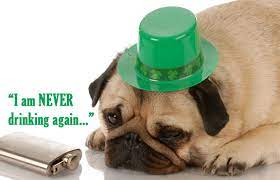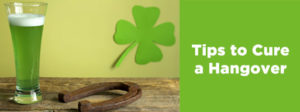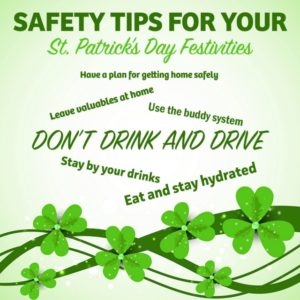“In dealing with Saint Patrick’s Day hangover’s for some people Global news states the following: Hangovers are essentially the body’s reaction to a poison. It’s a substance that stays in the body for a long time and is taken care of by the body by only small amounts by the hour,” Dr. John MacNeill, a pharmacologist and University of British Columbia professor, told Global News.”
Dealing with the St. Patrick’s Day Hangover!
Dr. Hensrud adds that, as we age, we get dehydrated more. Our liver doesn’t work as efficiently, and our bodies don’t fight inflammation as well so it takes longer to recover.
Speaking of recovering, are there really any proven ways to get rid of a hangover?
According to Healthline.com, it is recommended to drink a glass of water after every drink to stay hydrated. If it’s too late for that, drink plenty of water the next day.
What about having a drink in the morning? Healthline says it’s largely a myth, but there is some evidence to support having a drink can lessen hangover symptoms.
The best thing to do? Sleep, and once you sleep, get up and eat a hearty breakfast. It boosts your blood sugar levels and makes you feel better.
That’s verified.
1. Drink water between every alcoholic drink you consume. The water will keep you hydrated since alcohol tends to dehydrate us. It will also help to flush the alcohol out of your system.
2. Do not opt for the “hair of the dog” that bit you the next day! That’s the old belief that if you have a little bit of alcohol the next morning that it will act as a cure for your hangover.
After all, that IS what Sunday brunches are built on, right? Well, new evidence from a study suggests recently that this is not the way to cure a hangover and it actually can just prolong the onset of that “crappy feeling.”
3. Be mindful about what you drink! Darker liquor tends to give you the worst hangovers. Stick with vodka and stay away from any mixed drink that is full of sugar as that too can just make you feel worse tomorrow morning.
4. Eat a big meal! If you’re hitting up an Irish Pub for some Guinness today order some Shephard’s Pie with it. All those carbs will help prevent being hungover and read meat is full of amino acids which can also aid in preventing tomorrow’s possible doom!
5. Just limit how much you drink or don’t drink at all! Just because it’s one of the biggest drinking holidays of the year doesn’t mean you have to go crazy or even participate for that matter. Sometimes it’s the best to be the only sober one in a bar full of crazy drunks.
Of course, whatever you do this St. Patrick’s Day, make sure you drink responsibly. Never drink and drive.
QUOTE FOR THURSDAY:
How to plan a safe St Patrick’s Day!
With 149 million people in the United States celebrating on Saint Patrick’s Day – an incredible figure for a holiday that is not legally recognized as a holiday.
St. Patrick’s Day is the most popular holiday for beer drinking with the average person having 4.2 drinks and 32% of adult admitting to binge drinking. On St. Patrick’s Day beer sales increase 174% and spirit sales increase 153%.
Unfortunately, a holiday that celebrates drinking, leads to drunk driving and alcohol-related accidents. These accidents are often fatal. In 2018, 73 people in the US were killed in drunk driving crashes over on St. Patrick’s Day.
If possible; Plan a Sober Ride
Drinking during Saint Patrick’s Day is not uncommon. But if you do choose to enjoy a cocktail or two, keep yourself and those around you safe by planning for a sober ride. Ask a sober friend or family member to take you home. Take an Uber, planned ride or even an old fashioned cab if that is your preferred method. You can even take a bus or train depending on where you live and where the party is from. Even in your sober ride, act appropriately so your driver can pay attention to the road. Remember, your driver may be sober, but there’s likely another driver near that is not.
Don’t Drink and Drive:
This first Saint Patrick’s day safety tip is obvious for a reason. Drinking and driving is not only dangerous to yourself but also everyone else in the vicinity of your vehicle. It should come as no surprise that January 1st has the highest percentage of deaths related to alcohol, according to the Insurance Institute for Highway Safety data. Between 2007 and 2011, 42 percent of all traffic deaths during the holiday were directly caused by alcohol. Keep others from driving while intoxicated by suggesting they use other methods, like an Uber.
Party at someone’s house sleepover if possible or have a sober driver!
Eat Dinner:
First if going out at dinner have a full stomach since it is a great way to avoid alcohol poisoning.
Try to consume foods high in protein such as cheese, meat and nuts. These types of food will slow down the absorption of alcohol in the digestive system. This will give the alcohol more time to metabolize in the body resulting in a lower risk of alcohol poisoning. Our liver metabolizes about one alcoholic drink per hour. A good rule of thumb is a 12 oz. beer = 4-5 oz. of wine = 1.5 oz. of hard liquor. By sipping a drink rather than chugging it, your body will have more time to metabolize the alcohol which will result in less of a hangover. Consider ordering an appetizer if you’re out at a restaurant or snack on nuts while drinking at a bar.
Pet Safety:
Nothing frightens pet’s more than sudden loud noises. Extra attention must be given so your pets won’t run away in a panic. Scared, running pets can be hit by cars, cause accidents, and become lost…not to mention, frequently bite people if scarred or threatened.
Wait to Post on Social Media:
Yes, it’s tempting to document your holiday celebrations online with friends and family, but recommended is waiting until you’ve returned home to share. You never know who’s looking at your account and what their intentions may be.
QUOTE FOR TUESDAY:
“Approximately 4.1 percent of men and women will be diagnosed with colorectal cancer at some point during their lifetime, based on 2016–2018 data. Rate of New Cases and Deaths per 100,000: The rate of new cases of colorectal cancer was 37.8 per 100,000 men and women per year. The death rate was 13.4 per 100,000 men and women per year. These rates are age-adjusted and based on 2014–2018 cases and 2015–2019 deaths. In 2018, there were an estimated 1,365,135 people living with colorectal cancer in the United States.”.
National Cancer Institute (https://seer.cancer.gov/statfacts)
QUOTE FOR MONDAY:
“Colorectal cancer is the 2nd leading cause of cancer death among men and women combined in the United States. 25 to 30 percent of colorectal cancer patients have a family history of the disease.”
Fight Colorectal Cancer (https://fightcolorectalcancer.org/)
QUOTE FOR THE WEEKEND:
“The following risk factors we can control that put us at increase risk for developing colon cancer are:
- a diet high in red, processed, or charred meats
- a lack of exercise
- obesity, particularly extra fat around the waist
- smoking (studies show that smokers are 30 to 40 percent more likely to die of colorectal cancer)
- drinking too much alcohol”
Memorial Sloan Kettering Cancer Center
QUOTE FOR FRIDAY:
‘The entire colon is about 5 feet (150 cm) long, and is divided into five major segments. The rectum is the last anatomic segment before the anus which is not part of the colon.”
National Cancer Institute (SEER Training Modules)
QUOTE FOR THURSDAY:
“There is no cure for MS but there are over a dozen disease modifying therapies (DMTs) licensed to treat relapsing and some forms of progressive MS. Taking one can mean you get fewer, and less serious, relapses. They can also slow down how fast your MS gets worse.
Lots of people with MS find it useful to actively manage their health in other ways, like through diet, exercise or giving up smoking.”
MS Society (https://www.mssociety.org.uk)
QUOTE FOR WEDNESDAY:
“Multiple sclerosis is a disease that impacts the brain and spinal cord which make up the central nervous system and controls everything we do. The exact cause of MS is unknown, but we do know that something triggers the immune system to attack the brain and spinal cord. The resulting damage to myelin, the protective layer insulating wire-like nerve fibers, disrupts signals to and from the brain. This interruption of communication signals causes unpredictable symptoms such as numbness, tingling, mood changes, memory problems, pain, fatigue, blindness and/or paralysis. Everyone’s experience with MS is different and these losses may be temporary or long lasting.”
National Multiple Sclerosis Society (https://www.nationalmssociety.org/What-is-MS)




